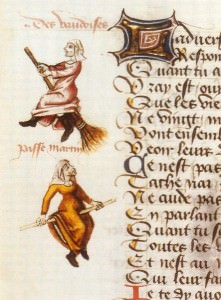Mythologies of Witchcraft in the Fifteenth Century
Kieckhefer, Richard
Magic, Ritual, and Witchcraft, Volume 1, Number 1, Summer (2006)
Abstract
The European witch trials that began in the fifteenth century have been explained in many ways, but always assuming that witchcraft was a unified concept. Work on the history of witchcraft has come to a point at which we both can and must rethink this and other basic assumptions about the rise of these trials. We must reconsider how far the concept of witchcraft was consolidated into a single imaginative construct during the fifteenth century, and how the mythology of witchcraft functioned in distinct places. Most basically, we must ask anew how useful standard models of historical explanation are for understanding the early witch trials.
At the turn of the twentieth century, Joseph Hansen traced the evolution of what he called the “collective concept” ( Kollektivbegriff ) of witchcraft, corresponding to what we would now call the imaginative world of the Sabbath. All the components of this concept had their separate histories: the nocturnal assembly, flight through the air with demonic assistance, the pact with the devil, sexual intercourse with incubi and succubi, and bewitchments or maleficia. In Hansen’s construction, which has never seemed controversial, it was in the fifteenth century that these notions fused into a cohesive notion of witchcraft, to which the Sabbath was of central importance. Whether agreeing or disagreeing with Hansen in other respects, historians have followed his lead in all this, accepting as a given that in the fifteenth century there was a more or less established conception of witchcraft.
Mythologies of Witchcraft in the Fifteenth Century
Kieckhefer, Richard
Magic, Ritual, and Witchcraft, Volume 1, Number 1, Summer (2006)
Abstract
The European witch trials that began in the fifteenth century have been explained in many ways, but always assuming that witchcraft was a unified concept. Work on the history of witchcraft has come to a point at which we both can and must rethink this and other basic assumptions about the rise of these trials. We must reconsider how far the concept of witchcraft was consolidated into a single imaginative construct during the fifteenth century, and how the mythology of witchcraft functioned in distinct places. Most basically, we must ask anew how useful standard models of historical explanation are for understanding the early witch trials.
At the turn of the twentieth century, Joseph Hansen traced the evolution of what he called the “collective concept” ( Kollektivbegriff ) of witchcraft, corresponding to what we would now call the imaginative world of the Sabbath. All the components of this concept had their separate histories: the nocturnal assembly, flight through the air with demonic assistance, the pact with the devil, sexual intercourse with incubi and succubi, and bewitchments or maleficia. In Hansen’s construction, which has never seemed controversial, it was in the fifteenth century that these notions fused into a cohesive notion of witchcraft, to which the Sabbath was of central importance. Whether agreeing or disagreeing with Hansen in other respects, historians have followed his lead in all this, accepting as a given that in the fifteenth century there was a more or less established conception of witchcraft.
Click here to read this article from Magic, Ritual, and Witchcraft
Subscribe to Medievalverse
Related Posts